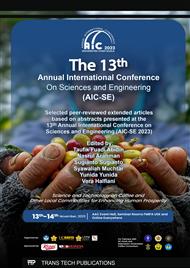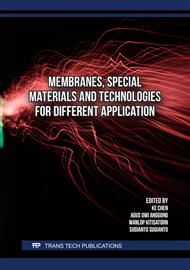p.3
p.11
p.17
p.27
p.35
p.49
p.55
p.61
Characterization and Performance of CA/Chitosan Membrane from Golden Snail Shell in the Application of Humic Acid Purification
Abstract:
The removal of humic acid from water is accomplished by a process known asultrafiltration membrane. This study investigates the simple method of preparing cellulose acetate (CA)-based ultrafiltration membranes by introducing chitosan into the dope solution. The result shows the positive effect of incorporating chitosan (1-3 wt%) as a membrane additive on their characteristics and performance. The membranes exhibit improved properties including increased bulk porosity and hydrophilicity. The pure water flux is significantly improved, reaching 100 L/m2.h with 3 wt% chitosan compared to 47 L/m2.h for the pure CA membrane. In particular, the 1% chitosan modification shows optimal performance, achieving high flux (82 L/m2.h) and humic acid rejection (80%). Furthermore, the modified CA membrane shows stability in both acidic and alkaline solutions over a 24 h exposure. These results suggest promising prospects for the application of chitosan-modified CA membranes in efficient water purification processes.
Info:
Periodical:
Pages:
27-34
Citation:
Online since:
December 2024
Keywords:
Price:
Сopyright:
© 2024 Trans Tech Publications Ltd. All Rights Reserved
Share:
Citation:




